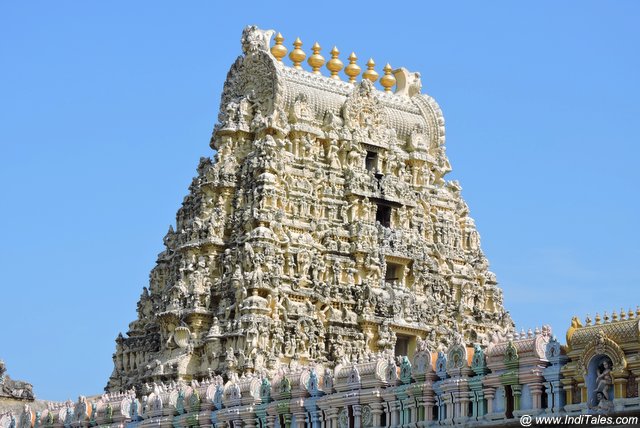Sri Kanchi Ekambareswarar Temple, Kanchipuram

Address
Sri Kanchi Ekambareswarar Temple, Sannathi Street, Periya, Kanchipuram, Tamil Nadu 631502
Diety
Ekambareswarar Amman: Elavarakurli Ammaiyar
Introduction
Ekambareswarar Temple (Ekambaranathar Temple) is a Hindu temple dedicated to the deity Shiva, located in the town of Kanchipuram in Tamil Nadu, India.It is significant to the Hindu sect of Saivism as one of the temples associated with the five elements, the Pancha Bhoota Stalas, and specifically the element of earth, or Prithvi. Shiva is worshiped as Ekambareswarar or Ekambaranathar, and is represented by the lingam, with his idol referred to as Prithvi lingam. His consort Parvati is depicted as Elavarkuzhali. The presiding deity is revered in the 7th century Tamil Saiva canonical work, the Tevaram, written by Tamil saint poets known as the nayanars and classified as Paadal Petra Sthalam. The temple also houses Nilathingal Thundam Perumal temple, a Divyadesam, the 108 temples revered in the Vaishnava canon Nalayira Divya Prabhandam
Puranic Significance
This vast temple is one of the most ancient in India having been in existence since at least 600 CE. Second-century-CE Tamil poetry speaks of Kama kottam, and the Kumara kottam (currently the Kamakashi Amman temple and the Subramanya temple). The temple finds mention in the classical Tamil Sangam literature dated 300 BCE like Manimegalai and PerumpāṇāṟṟuppaṭaiInitially temple was built by Pallavas. Legend has it that once Parvati, the consort of Shiva, wanted to expiate herself from sin by doing penance under the temple’s ancient Mango tree near Vegavathi river. In order to test her devotion Shiva sent fire on her. Goddess Parvati prayed to her brother, Vishnu, for help. In order to save her, he took the Moon from Shiva’s head and showed the rays which then cooled down the tree as well as Parvati. Shiva again sent the river Ganga (Ganges) to disrupt Parvati’s penance. Parvati Request to Ganga and convinced her that both of them were sisters and so should not harm her. Subsequently, Ganga did not disturb her penance and Parvati made a Shiva Linga out of sand to get united with Shiva. The God here came to be known as Ekambareswarar or “Lord of Mango Tree”. According to another legend, it is believed that Parvati worshipped Shiva in the form of a Prithivi Lingam (or a Lingam improvised out of sand), under a mango tree.
Beliefs
The goddess of the goddess Elavarukulali, the world of the world, and the way through the sacred way to get to Kanchipuram. There he saw the Lord Shiva standing on the shore of the gate of the temple. Then the crowd was multiplied. She was afraid of the grandmother. Then the Linga Thumeni of the Lord appeared to be seen as a torn hollow tip. That’s the name of the pyramidnantha name of Lord Shiva.
Special Features
The temple covers an area of over 23 acres (93,000 m2).Reaching a height of 59 m (194 ft), the temple’s Raja gopuram (the entrance tower to the temple) is one of the tallest in South India.The bottom half of the gateway tower has the shrines of Vinayaka and Murugan on either sides. From the entrance, there are two halls namely Vahana Mandapam (vehicle hall) and Sarabesa Mandapam (also called Navaratri hall). he Aayiram Kaal Mandapam, or the “hallway with a thousand pillars”, which was built by the Vijayanagar Kings, is found on precinct after the gateway tower. There is said to have been an underground holy river. The fourth courtyard contains a small Ganesha temple and a pond. The third courtyard contains lot of smaller shrines. The flag staff of the temple is axial to the sanctum and diagonally located to the main entrance and the temple tank on either directions. There is a shrine called Thirukachi Mayanam and Kalayana Mandapa, named after Pachayappa Mudaliar, both of which are located close to the flag staff. Thirukachi Mayanam, Valeesam, Rishabesam and Satyanadeesam are located in four corners of the temple. The hall of the flagstaff has pillars sculpted with intricate figures indicating various legends and avatars of Shiva.The sanctum sanctorum contains the lingam along with the image of Shiva.There are granite image of the 63 Nayanmars around the first precinct.The temple’s inner most precinct are decorated with an array of Shivalingam, one of which is a Sahasra Lingam with 1,008 Siva lingams sculpted on it.There is no separate shrine for Parvati within the complex as with all other Shiva temples in Kanchipuram. A local belief is that Kamakshi Amman Temple is the consort for Ekambaranathar. Behind the image of Lingam in the sanctum, there is a depiction of Shiva Parvathi in a plaque with Shiva depicted as Tazhuva kuzhainthaar and Parvathi as Elavar Kuzhali.There is a small shrine for Vishnu named Nilathingal Thundam Perumal temple inside the temple complex. Vishnu is prayed as Vamana Murthy and the shrine is hailed by the Alvar saints as one of the 108 Divya Desams. There is a separate shrine for Nataraja on the second precinct.
Festivals
The temple priest perform the pooja (rituals) during festivals and on a daily basis. Like other Shiva temples of Tamil Nadu, the priests belong to the Shaivaite community, a Brahmin sub-caste. The temple rituals are performed six times a day; Ushathkalam at 5:30 a.m., Kalasanthi at 8:00 a.m., Ucchikalam at 10:00 a.m., Sayarakshai at 6:00 p.m., Irandamkalam at 8:00 p.m. and Ardha Jamam at 10:00 p.m. Each ritual comprises four steps: abhishekam (sacred bath), alankaram (decoration), naivedyam (food offering) and deepa aradhanai (waving of lamps) for the pedestal of Ekambareswarar. Since it is a Lingam made of sand mound, all the ablution is done only to the pedestal. The worship is held amidst music with nagaswaram (pipe instrument) and tavil (percussion instrument), religious instructions in the Vedas read by priests and prostration by worshippers in front of the temple mast. There are weekly rituals like somavaram and shukravaram, fortnightly rituals like pradosham and monthly festivals like amavasai (new moon day), kiruthigai or on krittika nakshatram, pournami (full moon day) and chaturthi. The temple celebrates dozens of festivals throughout the year. The most important of these is the Panguni (or Phalguni in devanagari) Brahmotsavam that lasts ten days during the Tamil month of Panguni, between March and April, concluding with the celebration of Kalyanotsavam. The festival is the most popular of all the temple festivals in Kanchipuram.
Century/Period/Age
1509 AD
Managed By
Hindu Religious and Charitable Endowments (HRCE)
Nearest Bus Station
Kanchipurem
Nearest Railway Station
Kanchipurem
Nearest Airport
Chennai










